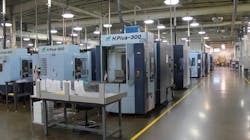Medical Device Manufacturer Norwood Signs PPA to Support ENGIE Wind Farm in Texas
Dayton, Ohio-based healthcare equipment manufacturer Norwood Medical has signed a five-year wind power purchase agreement with developer ENGIE Resources.
The five-year PPA essentially invests in ENGIE North America’s Priddy Wind project in Texas. Under most PPAs the large-scale customer does not receive the renewable energy directly, but the investment helps finance the project and, in this case, works to offset the Norwood Medical’s building energy use and emissions with some 120,000 renewable energy credits (RECs).
As per the terms of the contract, Norwood Medical will initially match 50% of its electricity consumption at four locations. The company will increase its commitment to 100% for 11 buildings over the agreement’s term.
"We have a goal of 50% reduction of scope 1 and 2 emissions by 2030 versus baseline year of 2021, and net zero by 2050," Jeremiah Allen, Vice President, Engineering at Norwood Medical, said in a statement. "Leveraging renewable electricity will help us hit our goal to reduce greenhouse gas emissions by 50% from 2021 levels."
Related news: AMN Aims for 90% GHG Emissions Reduction
Norwood Medical will procure Green-e Certified RECs delivering the equivalent environmental benefits of avoiding the greenhouse gas emissions from 52 million pounds of coal burned, or 47,223 metric tons of CO2. Green-e RECs are certified by the nonprofit Center for Resource Solutions to verify exclusive use of renewable electricity within an electricity market.
"Norwood asked us for a comprehensive analysis of their usage, plans for growth, historic prices and the forward fixed market,” said Ron Cantlie, President/Partner at Statistical Energy. “This led us to a structure with some market-based risk and float on the market, rather than to lock in a price now."
Norwood Medical manufactures “medtech” equipment such as cutting devices for cardiovascular surgery, stapling systems for minimally invasive surgeries, implants for orthopedic procedures and robotic assisted surgical instruments.
Other U.S. healthcare companies and facilities which have invested in decarbonization strategies include California’s Valley Children’s Healthcare, has contracted for an on-site renewable energy microgrid. Boston Medical Center on the east coast is collaborating with Takeda to identify and reduce hard-to-abate greenhouse gas emissions from the disposal of medical waste such as pharmaceutical packaging.
In January, hospital operations firm OSF Healthcare signed a 20-year community solar PPA with Summit Ridge Energy. The OSF PPA is subscribing to 14 community solar projects totaling 24 MW across Illinois.
Various sectors and facilities within the healthcare industry are working on various decarbonization and energy resiliency strategies including microgrids, energy efficiency and renewable energy PPAs. Learn more about healthcare microgrids in a content session at Microgrid Knowledge Conference happening April 15-17 in Dallas.
About the Author
Rod Walton, EnergyTech Managing Editor
Managing Editor
For EnergyTech editorial inquiries, please contact Managing Editor Rod Walton at [email protected].
Rod Walton has spent 17 years covering the energy industry as a newspaper and trade journalist. He formerly was energy writer and business editor at the Tulsa World. Later, he spent six years covering the electricity power sector for Pennwell and Clarion Events. He joined Endeavor and EnergyTech in November 2021.
Walton earned his Bachelors degree in journalism from the University of Oklahoma. His career stops include the Moore American, Bartlesville Examiner-Enterprise, Wagoner Tribune and Tulsa World.
EnergyTech is focused on the mission critical and large-scale energy users and their sustainability and resiliency goals. These include the commercial and industrial sectors, as well as the military, universities, data centers and microgrids. The C&I sectors together account for close to 30 percent of greenhouse gas emissions in the U.S.
He was named Managing Editor for Microgrid Knowledge and EnergyTech starting July 1, 2023
Many large-scale energy users such as Fortune 500 companies, and mission-critical users such as military bases, universities, healthcare facilities, public safety and data centers, shifting their energy priorities to reach net-zero carbon goals within the coming decades. These include plans for renewable energy power purchase agreements, but also on-site resiliency projects such as microgrids, combined heat and power, rooftop solar, energy storage, digitalization and building efficiency upgrades.

